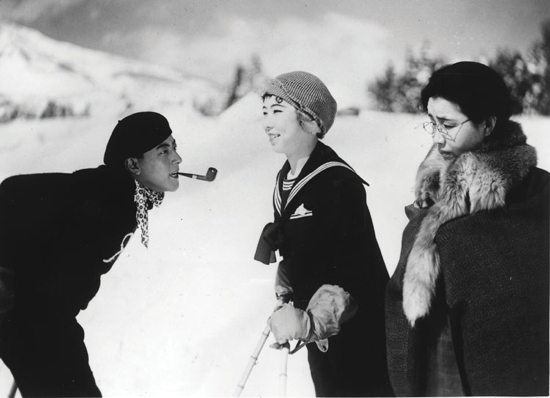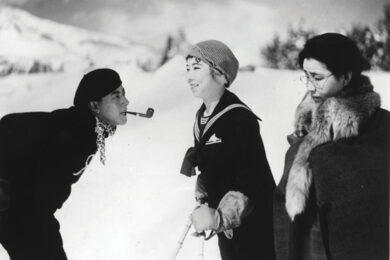The tale is a familiar one from film history. Akira Kurosawa’s Rashomon is selected for competition at the 1951 Venice Film Festival, scoops the top prize and, in the process, allows the critics to finally discover Japanese cinema. Within the year an Academy Award for this ‘Most Outstanding Foreign Film’ has been hastily created, a sure sign that the West had embraced its director. The ensuing relationship worked both ways: Kurosawa, heavily influenced by American pulp novels and crime flicks, produced works that could be easily consumed by a non-Japanese audience and maintain their foreign allure. He adapted Shakespeare and Dashiell Hammett, but placed their dramas in Japan’s past, to feudal times and with samurai occupying the leads. When he stayed in the present day it was more often than not for post-war gangster movies, as tough and sentimental as their US counterparts. Then there were the films that returned the influence: Yojimbo set the template for A Fistful Of Dollars and its countless imitations; Seven Samurai lent itself to various remake permutations, whether Western (The Magnificent Seven), science fiction (Battle Beyond The Stars) or even Pixar animation (A Bug’s Life).
Kurosawa wasn’t the only beneficiary of this newfound interest in Japanese cinema. The quiet family dramas of Yasujiro Ozu, a filmmaker approaching the final decade of his career as Rashomon hit, found similar favour – Tokyo Story, in particular, becoming a permanent fixture in critics’ polls and ‘greatest ever’ lists. At the opposite end of the spectrum Godzilla crossed over into the mainstream, its atomic age politics gradually diluted through re-edits, remakes, even a cartoon series for the kids, and yet a cult following still lingers. With critics now paying greater attention many more filmmakers were heralded as the years progressed, and so too other cult oddities emerged, but none has managed to break Kurosawa’s monopoly on the popular perception. For many he simply is classic Japanese cinema and that looks unlikely to change. So long as the likes of Seven Samurai remain so readily available, and so long as Hollywood and others continue to remake and ‘re-imagine’, his presence will always be strongly felt.
The side-effect of this stranglehold is that Japanese cinema, outside of Kurosawa and a few select titles, can be seen as unmarked territory. For many years this was true: availability was key and all we had were a handful of videotapes devoted to the director’s major works or the occasional genre title rendered as chopped-up, atrociously dubbed trash. Hope lay almost exclusively with BBC2 and Channel 4: an intermittent TV screening devoted to Japanese cinema was usually the annual late-night showing of Yojimbo (or so it seemed), but others would slip through the cracks. These were rare glimpses beyond the seven samurai and that most famous of Japanese directors, all the more tantalising because they were so few. It was only with the advent of DVD in the late ’90s that doors truly began to open, thanks to increasingly adventurous labels and the viewers to match.
Fast-forward a decade or so and we now find an abundance of choice. Aspiring cinephiles are expected to differentiate between, say, the female-centred melodramas of Mikio Naruse and the politically engaged anger of Nagisa Oshima. No longer is this a national cinema summed up by a single filmmaker and men in monster suits rampaging through capital cities. The British Film Institute – providers of all those Kurosawa videotapes and DVDs over the years – are currently in the midst of a massive project dedicated to Ozu. Within the space of three years, 32 of his films will be released and in high definition where possible (a sure sign that this series is being taken very seriously). Meanwhile the Masters of Cinema range does something similar with Shohei Imamura. Their project isn’t quite so extensive, but nevertheless we are seeing a steady stream of Blu-rays and DVDs equally willing to highlight the key works and the forgotten gems. This month sees the latest instalments from both collections hitting the shelves.
Having embarked on their Ozu releases in the summer of 2010, the BFI has, by this point, issued many of the major works. Unsurprisingly, perennial critics’ favourite Tokyo Story was among the first to emerge. Each film, until now, found itself paired with one of the lesser-known, earlier entries from the director’s catalogue. Thus the viewer would get to see and own a masterpiece – that wonderful tale of youth, Good Morning; that heartbreaking tale of old-age, An Autumn Afternoon; and so on – but also be slowly weaned onto the obscurer stuff. Almost two years into the project and we’re now finding these lesser-known, earlier entries getting a top billing. The Student Comedies heads back to the beginnings of Ozu’s career to unearth a quartet of silent features from the late ’20s and early ’30s. As their collective title suggests, these are lightweight offerings, broad and a little bit silly. Despite the educational setting the focus is on slacker-types, taking a laidback approach to their adolescence and those first flowerings of teenage romance.
Ozu was just 25 when he made his first film in this set, Days Of Youth from 1929. He hadn’t gone to college himself, but nevertheless there is a definite affinity between the director and those in front of his camera. Their youthful antics translate into a youthful style, almost unrecognisable from that more sober and refined technique he would gradually hone over the years. There’s an energy to these films that proves infectious, one that took its cue from Hollywood. Like Kurosawa, Ozu was also in thrall to American cinema – one of the reasons he didn’t make it into college was reportedly owing to his continual bunking off school in order to see favourite stars. He pays homage to them in The Student Comedies, the walls of various digs adorned with posters of Laurel and Hardy and Harold Lloyd flicks. The latter, in particular, seems to have had an overt effect on their director, with Lloyd-alike characters (complete with rounded spectacles and naïve romantic ideals) being a regular fixture.
Little survives of Japanese cinema from this period – just one of the lasting effects of firebombing raids during the Second World War – making it hard to tell whether Ozu’s idolisation was a personal quirk or something far more widespread. Certainly, the whole ‘student comedy’ genre was commonplace enough during these years. They can prove a tad interchangeable as the BFI set shows, but that’s only part of the story. Despite such cultural specifics as the militaristic uniforms the young men wear to classes, these are teen comedies of the kind you’ll find from any country or any decade. The classroom banter in I Flunked, But… is no different to that found in a British Will Hay film or a knockabout Kemal Sunal movie from Turkey. The liner notes, meanwhile, make assorted nods to the likes of Grease and Miramax atrocity She’s All That. Such reference points aren’t wilful or outlandish either, rather they make perfect sense. These may be silent movies, but beneath the wear-and-tear and other signs of age this kind of stuff is universal.
Conversely, the cinema of Shohei Imamura very specifically relates to Japan. His films targeted the underbelly of his homeland, opting to view from the perspective of a pimp (Pigs And Battleships), a serial killer (Vengeance Is Mine) or a pornographic filmmaker (The Pornographers). The latest release from Masters of Cinema pairs 1963 classic The Insect Woman with his rarely seen second feature Nishi Ginza Station. The former offers up the first half of the 20th century as experienced through the eyes of a prostitute. The latter is barely an hour in length and makes do with sticking firmly in the present day. Yet both position Japan in the same light: as a country marked by sex, booze and post-traumatic stress. There is no room for sentimentality here (arguably making Imamura something of an anti-Kurosawa); their director doesn’t do ‘tart with a heart’ tales or provide us with neat and tidy endings. He shows us the used and repeatedly abused, and makes it clear that they’ll continue to suffer long after the end credits have rolled. The ‘insect’ woman of the title is just that: crawling along, destined to make the same mistakes over and over, never quite learning from them.
Imamura’s films are hardly crowd pleasers – an understatement – but they do exert a strong fascination. The Masters of Cinema pair refuse to shy away from what he sees as the true face of Japan, with The Insect Woman even throwing in newsreel excerpts to back up such claims. In black and white and widescreen, to the accompaniment of punchy jazz, they reveal all of the sweaty anxiety inherent in the country at the time. Amazingly, Imamura was just as gritty and honest when making films in his seventies. The Eel, also released on DVD this month by Artificial Eye, was a tale of mental illness, murder, suicide, revenge and strange sexual attraction. It was also a comedy and, needless to say, somewhat removed from the cinema of Kurosawa. Indeed, if you’re looking for something beyond the most famous of his tales then Imamura is as far away as you could imagine. And spare a thought too for young Ozu and his cute teenaged comedies: pratfalls, young love and not a samurai in sight.



